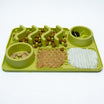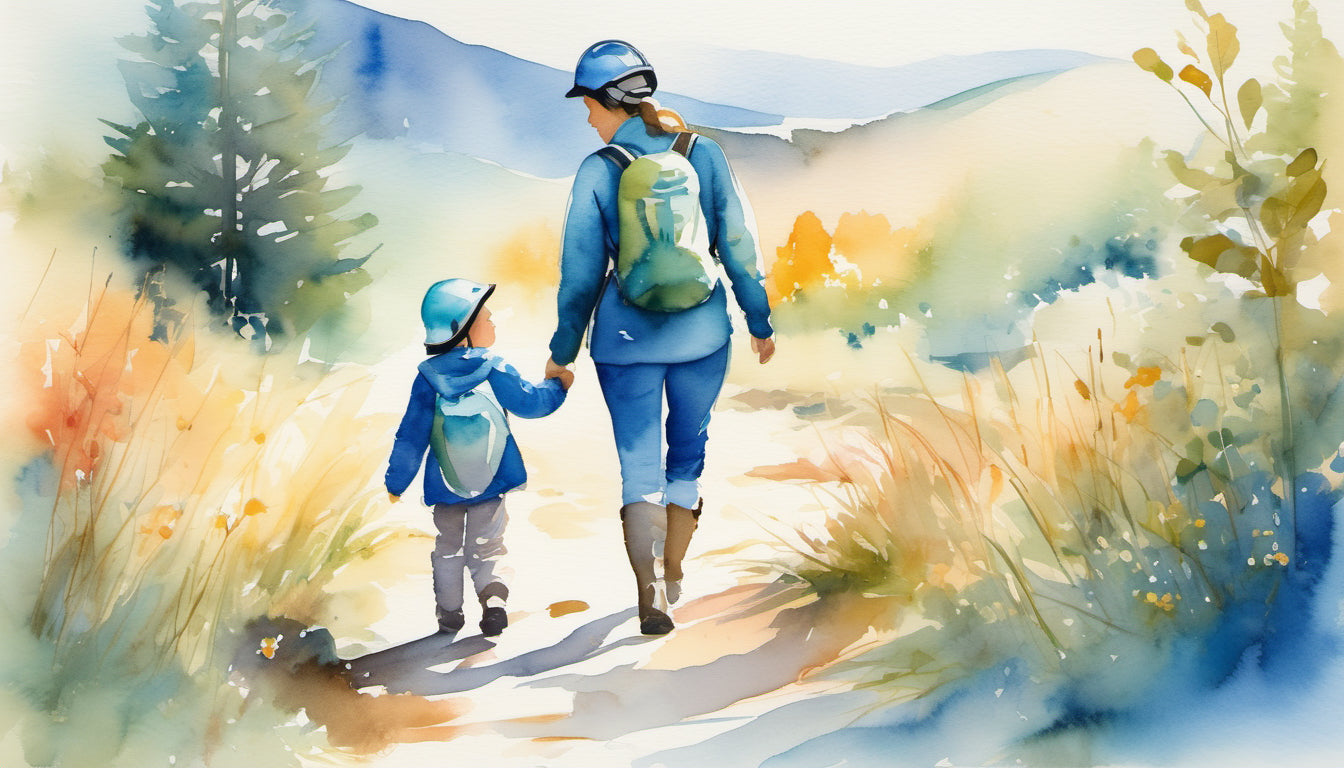Being a stay-at-home mom is a rewarding and challenging role. While you may spend most of your time indoors, it's important to remember the significance of outdoor activities for both you and your children. Engaging in outdoor adventures not only provides an opportunity for fun and relaxation but also offers numerous benefits for your physical and mental well-being.
In this article, we will explore the importance of outdoor safety for stay-at-home moms and provide you with essential tips and precautions to ensure a safe and enjoyable experience. From planning your outdoor adventures to understanding potential dangers and maintaining personal safety, we've got you covered. Let's dive in and discover how you can make the most of outdoor activities while keeping yourself and your loved ones safe.
Importance of Outdoor Safety for Stay-at-Home Moms
As a stay-at-home mom, it's important to prioritize outdoor safety for both yourself and your children. While spending time outdoors can be wonderful for everyone's mental and physical well-being, it's crucial to be aware of the risks and challenges that come with it. By taking the necessary precautions, you can ensure that your outdoor adventures are safe and enjoyable for the whole family.
Benefits of Outdoor Activities for Moms
Outdoor activities offer numerous benefits for stay-at-home moms, including:
- Physical health: Engaging in outdoor activities helps you stay active and maintain a healthy lifestyle. It can improve cardiovascular health, strengthen muscles, and boost immunity.
- Mental well-being: Spending time in nature has a positive impact on mental health. It reduces stress, improves mood, and increases overall happiness. It provides an opportunity for relaxation and rejuvenation.
- Bonding with children: Outdoor activities create opportunities for quality bonding time with your children. It allows you to connect with them on a deeper level and create lasting memories.
- Teaching opportunities: The great outdoors is a rich learning environment. It provides ample opportunities to teach children about nature, wildlife, and environmental conservation. It helps develop their curiosity and love for the natural world.
Risks and Challenges to be Aware of
While outdoor activities offer immense benefits, it’s important to be aware of the risks and challenges associated with them. Some common risks include:
- Injuries: Outdoor activities can sometimes lead to injuries such as sprains, cuts, and bruises. Being mindful of potential dangers and taking appropriate safety measures can greatly reduce the risk of these injuries.
- Environmental hazards: It's important to be aware of environmental hazards such as uneven terrain, slippery surfaces, and unpredictable weather conditions. These hazards can increase the risk of accidents and injuries.
- Sunburn and heat-related illnesses: Prolonged exposure to the sun without proper protection can lead to sunburn and heat-related illnesses. Stay-at-home moms, along with their children, should take precautions like wearing sunscreen, hats, and appropriate clothing to protect themselves from the sun's harmful rays.
- Allergic reactions: Outdoor environments can expose you and your children to various allergens like pollen, insect bites, and poisonous plants. Knowing how to recognize and deal with these allergens can help prevent allergic reactions.
By understanding the benefits and being aware of potential risks and challenges, you can make informed decisions and take proactive steps to ensure the safety of your family during outdoor activities. Stay tuned for our next section on Planning Outdoor Adventures for practical tips on how to prepare for your outdoor outings.
Planning Outdoor Adventures
Planning outdoor adventures is an important part of ensuring the safety of stay-at-home moms and their children. By carefully considering the location, weather conditions, and informing others about your plans, you can have a fun and worry-free experience. Here are some essential tips for planning outdoor adventures:
Choosing Suitable Locations
When planning outdoor activities, it's important to choose locations that are suitable for you and your children. Consider the age and interests of your children when selecting a location. Look for parks, nature reserves, or trails that offer activities and amenities suitable for your family.
Tips:
- Research and explore local parks and recreational areas in your area.
- Look for places with child-friendly amenities, such as playgrounds or picnic areas.
- Consider the distance and accessibility of the location from your home.
Check Weather Conditions
Weather conditions can greatly impact your outdoor adventure. Before heading out, check the weather forecast to ensure that you have appropriate clothing and gear. It's best to avoid extreme weather conditions, such as thunderstorms, heatwaves, or extreme cold.
Tips:
- Check weather forecasts from reliable sources, such as local meteorological websites or apps.
- Dress yourself and your children in layers to accommodate changing weather conditions.
- Pack rain gear or sun protection, such as hats and sunscreen, accordingly.
Informing Others about Your Plans
It's always a good idea to let someone know about your outdoor plans, especially if you're going alone with your children. Inform a family member, friend, or neighbor about your destination and estimated return time. This way, if something unexpected happens, someone will know where to find you.
Tips:
- Share your itinerary with a trusted person and provide them with contact information.
- Discuss specific details, such as the trail you plan to take or the area you'll be exploring.
- Update your contact person if there are any changes to your plans.
By carefully planning your outdoor adventures, you can ensure a safe and enjoyable experience for you and your children. Remember to choose suitable locations, check weather conditions, and inform others about your plans. Stay tuned for the next section on essential safety measures.
"By failing to prepare, you are preparing to fail." - Benjamin Franklin
Essential Safety Measures
When it comes to outdoor safety for stay-at-home moms, there are a few essential safety measures that should always be taken into consideration. These measures can help ensure a safe and enjoyable experience for both you and your children. Here are some important safety tips to keep in mind:
Pack a Well-stocked First Aid Kit
Carrying a well-stocked first aid kit is crucial when heading outdoors with your children. Accidents can happen, and having the necessary supplies on hand can make a big difference in how you respond to injuries. Some essential items to include in your first aid kit are:
- Band-aids of various sizes
- Antiseptic wipes
- Gauze pads
- Adhesive tape
- Tweezers
- Pain relievers
- Insect bite relief cream
- Sunscreen
- Emergency contact information
Remember to regularly check the expiration dates on your first aid supplies and restock as needed.
Dress Appropriately for the Outdoors
Choosing the right clothing and footwear is important for outdoor safety. Dressing appropriately can help protect you and your children from various elements and potential hazards. Here are some tips for dressing appropriately for the outdoors:
- Wear comfortable and breathable clothing that allows for easy movement.
- Dress in layers to accommodate changes in weather.
- Wear sturdy closed-toe shoes or hiking boots to protect your feet.
- Consider wearing a hat and sunglasses to shield your face from the sun.
By dressing appropriately, you can reduce the risk of discomfort and potential injuries while enjoying the outdoors.
Stay Hydrated and Pack Snacks
Staying hydrated is crucial when spending time outdoors, especially if you have children with you. Dehydration can lead to fatigue, dizziness, and other health issues. Make sure to drink plenty of water before heading out and bring extra water bottles with you. Additionally, packing healthy snacks can help keep you and your children energized throughout your outdoor adventures.
Some great snack options to consider are:
- Trail mix
- Fresh fruits and vegetables
- Granola bars
- Nut butter packets
- Cheese and crackers
Snacks should be easy to pack, non-perishable, and provide a good balance of nutrients to keep everyone satisfied and energized.
Remember, taking care of your own well-being is just as important as taking care of your children's. By following these essential safety measures, you can ensure a safe and enjoyable outdoor experience for the whole family. Stay prepared, dress appropriately, and stay nourished to make the most of your time in nature.
"Safety and security don't just happen, they are the result of collective consensus and public investment. We owe our children, the most vulnerable citizens in our society, a life free of violence and fear." - Nelson Mandela
Preparing for Potential Dangers
As an adventurous stay-at-home mom, it's important to be prepared for potential dangers that you may encounter while enjoying outdoor activities with your children. By taking a few precautions and being aware of these risks, you can ensure the safety of yourself and your little ones. Here are some tips to help you prepare for potential dangers:
Dealing with Insect Bites and Stings
Insects are a common nuisance when spending time outdoors, but their bites and stings can be more than just annoying. They can cause discomfort, itching, and even allergic reactions. Here's how you can deal with insect bites and stings:
- Use insect repellent: Applying an insect repellent with DEET or picaridin can help keep mosquitoes, ticks, and other insects at bay.
- Cover up: Dress yourself and your children in long-sleeved shirts, long pants, and closed-toe shoes to reduce the exposure of bare skin.
- Avoid fragrances: Floral perfumes and scented lotions can attract insects, so it's best to skip them when heading outdoors.
- Check for ticks: After spending time in wooded areas or tall grass, make sure to thoroughly check yourself and your children for ticks. Removing ticks promptly can lower the risk of tick-borne illnesses.
Protecting Against Sunburn
Spending time outdoors means being exposed to the sun's harmful UV rays, which can lead to sunburn, premature aging, and an increased risk of skin cancer. Protect your family from sunburn with these tips:
- Apply sunscreen: Use a broad-spectrum sunscreen with a high SPF and apply it generously to all exposed skin. Don't forget to reapply every two hours or after swimming or sweating.
- Seek shade: Take breaks under shady trees or bring a portable sun umbrella to provide shelter from the sun.
- Wear protective clothing: Dress yourself and your children in lightweight, long-sleeved shirts, wide-brimmed hats, and sunglasses to further shield against the sun's rays.
- Avoid peak hours: The sun's rays are strongest between 10 a.m. and 4 p.m., so try to plan outdoor activities earlier in the morning or later in the afternoon.
Recognizing Poisonous Plants
When exploring nature, it's crucial to be able to identify and steer clear of poisonous plants like poison ivy, poison oak, and poison sumac. Here are some tips to help you recognize these plants:
- "Leaves of three, let them be": Remember this popular saying when it comes to identifying poison ivy or poison oak. These plants typically have three leaflets.
- Learn their characteristics: Familiarize yourself with the appearance of these poisonous plants. Poison ivy has three shiny green leaves, poison oak has lobed leaves resembling oak leaves, and poison sumac has clusters of red stems with seven to thirteen leaflets.
- Teach your children: Make sure your children understand the importance of avoiding these plants and teach them how to identify them as well.
By being prepared for potential outdoor dangers and having the knowledge to handle them, you can provide a safe and enjoyable experience for yourself and your children. So gear up, stay vigilant, and make the most of your outdoor adventures!
Ensuring Child Safety
As a stay-at-home mom, your child's safety is always a top priority, especially when it comes to outdoor activities. Whether you're exploring a local park, going for a hike, or simply playing in the backyard, taking certain precautions can help keep your child safe. Here are some essential tips to ensure the safety of your little ones during outdoor adventures:
Supervision and Childproofing
- Always keep a close eye on your child, especially in unfamiliar environments or near bodies of water.
- Childproof your outdoor space by removing any potential hazards such as sharp objects, poisonous plants, or small choking hazards.
- Make sure your child is within your line of sight at all times, especially in crowded areas or when they are playing on playground equipment.
Choosing Age-Appropriate Equipment
- Select outdoor equipment that is suitable for your child's age and development level. For example, choose swings and slides that are appropriate for their size and climbing structures that they can safely navigate.
- Ensure that helmets and other safety gear, such as knee pads and elbow pads, are properly fitted and worn when riding bikes, scooters, or any other wheeled equipment.
- Avoid using equipment that has been recalled or is damaged, as it may pose a safety risk to your child.
Educating Children on Outdoor Safety
- Teach your child about basic outdoor safety rules, such as looking both ways before crossing the street, staying on designated paths, and not talking to strangers.
- Show them how to properly use any outdoor equipment or toys they may be playing with to avoid accidents or injuries.
- Encourage open communication with your child so they feel comfortable discussing any concerns or questions they may have about outdoor safety.
By implementing these precautions, you can help create a safe and enjoyable outdoor environment for your child to explore and play in. Remember, children learn best through observation and practice, so lead by example and demonstrate safe behaviors during your outdoor adventures.
Emergency Preparedness
Emergency preparedness is an essential aspect of outdoor safety for stay-at-home moms. By being proactive and ready for any unforeseen incidents or emergencies, you can ensure the safety and well-being of yourself and your children. Here are some key points to consider regarding emergency preparedness:
Knowing Basic First Aid
Being equipped with basic first aid knowledge can be extremely helpful in handling minor injuries or illnesses while outdoors. Consider taking a first aid course or doing some research to familiarize yourself with the following:
- CPR techniques
- Treating cuts, scrapes, and bruises
- Dealing with sprains and strains
- Handling allergic reactions and insect bites
- Recognizing the signs of heat stroke or hypothermia
Teaching Children Emergency Procedures
It is important to educate your children about what to do in case of an emergency. Teach them how to:
- Dial emergency numbers (such as 911) and provide vital information
- Stay calm and follow safety instructions given by adults
- Identify safe places to go in different outdoor settings (e.g., designated meeting points in parks or campgrounds)
- Use basic first aid techniques appropriate for their age and ability
Carrying Emergency Contact Information
Always make sure to carry important contact information with you when you are outdoors with your children. This information should include:
- Your own phone number and address
- Emergency contacts (such as a spouse, a trusted family member, or close friends)
- Your healthcare provider's contact information
- Any pertinent medical information about your children (e.g., allergies, medication requirements)
Consider having this information easily accessible, such as in your phone's contact list or on a laminated card in your wallet.
Pro Tip: Taking a first aid course will not only equip you with valuable skills but will also boost your confidence in handling emergencies.
Remember, teaching your children about emergency procedures will not only keep them safe but will also empower them to take action if needed.
Having emergency contact information readily available can save precious time in case of an emergency.
By practicing emergency preparedness, you can minimize the impact of unexpected events and ensure a safer outdoor experience for both you and your children. Remember, being prepared is always better than being caught off guard.
Engaging in Outdoor Activities
Engaging in outdoor activities is a great way for stay-at-home moms to stay active, reduce stress, and spend quality time with their children. Whether it's going for a hike, biking, or a day at the beach, being outdoors offers numerous benefits for both moms and kids. However, it's important to prioritize safety to ensure a fun and worry-free experience. In this section, we'll explore some safety tips and precautions to keep in mind when engaging in outdoor activities.
Safe Hiking and Walking Practices
Hiking and walking are popular outdoor activities that allow moms to enjoy nature and stay fit. To ensure a safe experience, here are some tips to keep in mind:
- Research the trail or route beforehand and choose one that is suitable for your fitness level and the age of your children.
- Wear appropriate footwear with good traction to prevent slipping and tripping.
- Dress in layers and wear sunscreen, even on cloudy days, to protect yourself from the sun's harmful rays.
- Carry a map, compass, or a GPS device and know how to use them in case you get lost.
- Stay on marked trails and avoid straying off the path to minimize the risk of getting lost or encountering dangerous wildlife.
Cycling and Biking Safety
Cycling and biking are excellent outdoor activities that provide cardiovascular exercise and an opportunity to explore your surroundings. Here are some safety precautions to follow:
- Always wear a properly fitted helmet to protect against head injuries.
- Check your bike's tires, brakes, and other components before each ride to ensure they are in good working condition.
- Follow traffic rules and ride in designated bike lanes whenever possible.
- Teach your children basic cycling safety, such as using hand signals and looking both ways before crossing the road.
- Stay alert and watch out for pedestrians, vehicles, and other cyclists.
Water Safety Precautions
When enjoying water activities, such as swimming or boating, it's important to prioritize water safety. Here are some measures to take:
- Ensure that both you and your children know how to swim or wear proper flotation devices.
- Choose swimming areas that are monitored by lifeguards.
- Teach your children about water safety rules, such as not diving into unfamiliar bodies of water.
- Use sunscreen even when in the water to protect against sunburn.
- When boating, make sure everyone wears life jackets and that you have the necessary safety equipment onboard.
Remember, safety should always be your top priority when engaging in outdoor activities. By following these tips and precautions, you can enjoy your time outside while minimizing the risk of accidents or injuries.
"Nature is not a place to visit. It is home." - Gary Snyder
Maintaining Personal Safety
When it comes to outdoor activities, ensuring personal safety is crucial, especially for stay-at-home moms. Here are some important tips to help you maintain personal safety while enjoying the great outdoors:
Trusting Your Instincts
Trusting your instincts can play a critical role in keeping yourself safe. If something feels off or suspicious, don't hesitate to remove yourself from the situation. Your intuition can often sense danger before your rational mind does.
Being Aware of Your Surroundings
Being aware of your surroundings is key to maintaining personal safety. Here are a few things you can do:
- Scan the area: Take a moment to scan the environment and identify any potential risks or hazards.
- Stay alert: Avoid distractions, such as using your phone excessively, that may prevent you from noticing potential dangers.
- Know the exits: Familiarize yourself with the exit points and escape routes wherever you go, whether it's a park or a hiking trail.
Using Self-Defense Techniques
While we hope that you never find yourself in a situation where you need to defend yourself, it is essential to be prepared. Here are a few self-defense techniques to consider:
- Take a self-defense class: Enroll in a self-defense class specifically designed for women. These classes teach you practical techniques to protect yourself and boost your confidence.
- Carry a personal safety device: Look into personal safety devices like pepper spray or personal alarms. These can provide an additional layer of security and help alert others if you're in danger.
Remember, personal safety should always be your top priority. Taking these precautions will allow you to enjoy your outdoor adventures with peace of mind.
"Safety doesn't happen by accident. It's a choice made consciously by everyone who participates in an outdoor activity."
Conclusion
In conclusion, prioritizing outdoor safety is crucial for stay-at-home moms. By following the tips and precautions mentioned in this article, you can ensure that both you and your children have a safe and enjoyable time outdoors. Remember to plan your adventures carefully, pack essential safety measures, prepare for potential dangers, prioritize child safety, be prepared for emergencies, and maintain personal safety. By implementing these strategies, you can create unforgettable memories with your family while keeping everyone protected.
Remember, safety should always be your top priority, no matter where you are or what you're doing. And if you ever feel the need for additional protection, consider empowering yourself with a personal safety alarm, such as the one offered by Empowered by Ashley. Our personal safety alarm is designed to deter potential attackers and provide you with a sense of security and reassurance. To learn more about our products and to enhance your personal safety, visit our website at empoweredbyashley.com.
Stay safe and enjoy your outdoor adventures with peace of mind!
Frequently Asked Questions
-
What are some outdoor safety strategies for stay-at-home moms?
Some outdoor safety strategies for stay-at-home moms include: 1. Always supervise children, 2. Create a safe play area, 3. Teach children about safety rules, 4. Use sunscreen and protective clothing, and 5. Be aware of potential hazards.
-
How can stay-at-home moms create a safe play area outdoors?
Stay-at-home moms can create a safe play area outdoors by: 1. Installing a fence or gate, 2. Removing hazardous objects, 3. Providing soft landing surfaces, 4. Using age-appropriate toys and equipment, and 5. Ensuring proper supervision.
-
What safety rules should stay-at-home moms teach their children for outdoor activities?
Stay-at-home moms should teach their children the following safety rules for outdoor activities: 1. Look both ways before crossing the road, 2. Stay within designated play areas, 3. Avoid talking to strangers, 4. Wear protective gear when biking or skating, and 5. Be cautious around water bodies.
-
Why is it important for stay-at-home moms to use sunscreen and protective clothing?
Stay-at-home moms should use sunscreen and protective clothing to shield their children from harmful UV rays, reduce the risk of sunburn and skin cancer, and promote overall skin health.
-
What are some potential outdoor hazards that stay-at-home moms should be aware of?
Stay-at-home moms should be aware of potential outdoor hazards such as: 1. Uneven surfaces and tripping hazards, 2. Poisonous plants and insects, 3. Sharp objects or debris, 4. Unsecured swimming pools, and 5. Extreme weather conditions.




















Leave a comment
This site is protected by hCaptcha and the hCaptcha Privacy Policy and Terms of Service apply.